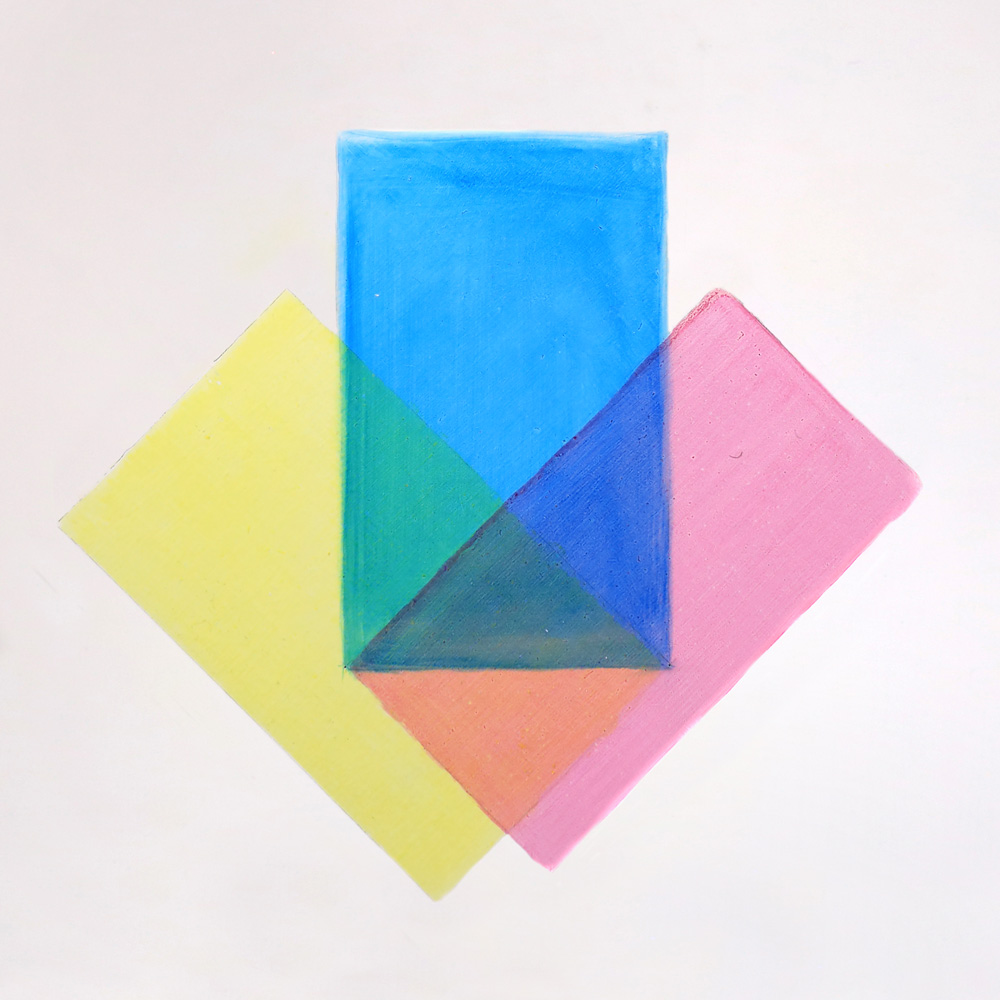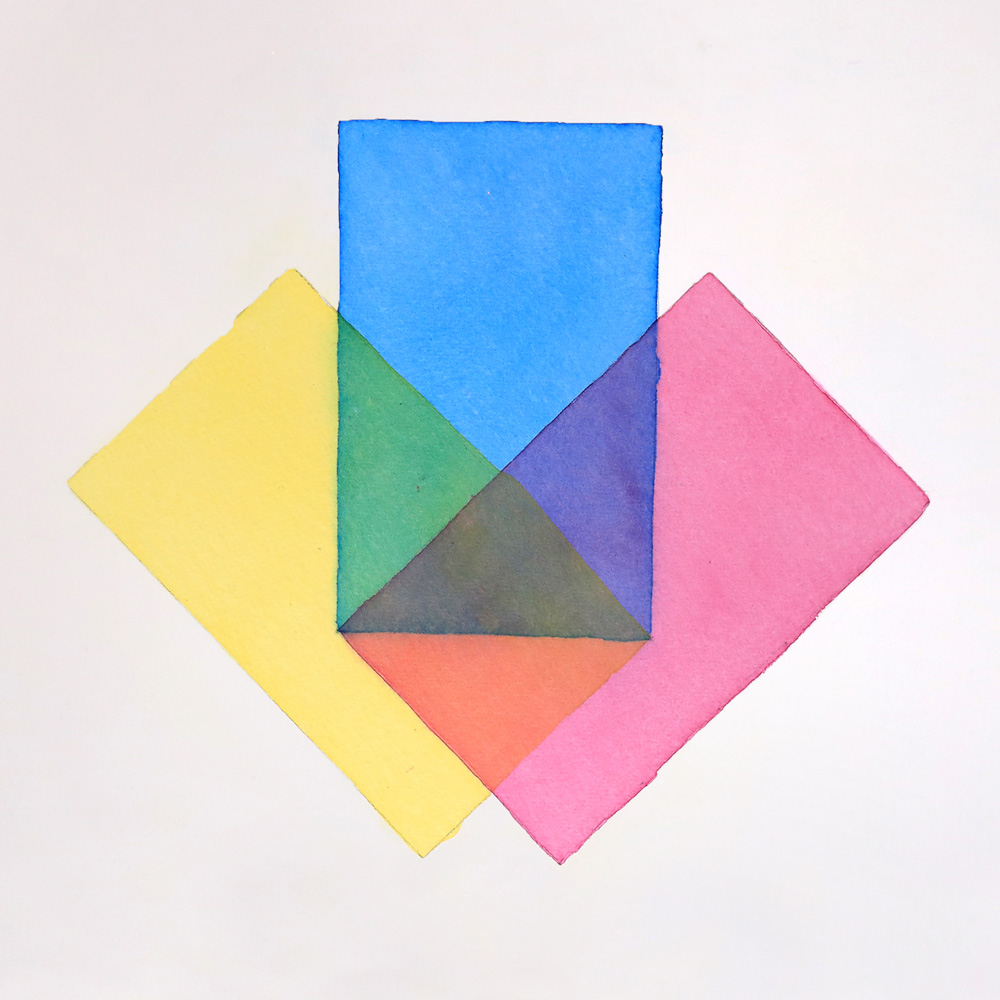The word “glaze” can have a very slightly different meaning whether you are painting with oils, acrylics or watercolor. In all three media, a glaze is a translucent layer of color applied on top of a base of other colors or an underpainting. This base layer could be a color field or imagery, as in the traditional techniques of imprimatura (toned ground) and grisaille (gray or neutral tonal underpainting). Layering several transparent colors on top of one another creates optical color mixtures which have a much different visual effect than physically mixing the same colors together. They can create visual depth, brilliance and luminosity.
Glazing with Acrylics:
One of the gifts and joys of glazing with acrylics is the quick drying time affords the artist the opportunity to push their artwork farther faster. As soon as one layer is touch dry, another can be applied on top and the number of layers need not be limited. There are very little rules with acrylics, as opposed to oil paints, with fat over lean and the slow drying time between layers. Glazing with acrylics can be much simpler and faster and the possibilities are endless! Glazing can be done with almost any acrylic medium with a little bit of paint added, as opposed to a wash, which is acrylic paint thinned with water. A glaze has more body than a wash. Gloss films have the most clarity and anything semi-gloss, satin or matte are hazy due to the matting solids added to reduce the gloss that is a characteristic of the acrylic resin. One thing to bear in mind when glazing with acrylics is the wet to dry color shift, due to the milky nature of the wet acrylic, which clarifies upon drying. This causes the color to dry a step darker and with the case of a glaze, more transparent, than it appears when wet.
Which medium you choose would be dependent upon the type of mark making you desire. Fluid mediums can be brushed on and will leave very little texture behind and gels will hold on to texture. There are many attributes which differentiate one medium from another including; thin and watery (low viscosity), which will dry to a very thin film or thicker, more viscous and syrupy (high viscosity), which will leave a film with more body. Rheology is another factor that makes mediums unique. A short rheology is something that will drip or plop when it hits the surface and long rheology is something that has a long string, like honey. We offer Glazing Liquid, available in Gloss or Satin, which has a slower drying time to ease with blending. Glazing Liquid has a low viscosity (thin) and short rheology (drips). It is important to let each layer dry properly before applying the next layer.
Acrylics can be layered almost endlessly. It is possible to build up a thick surface consisting of many, many layers. Choosing naturally transparent colors are easier to use with glazes, but if only a tiny bit of color is added to the medium, a translucent glaze can also be made with a naturally opaque color. Glazing is a great way of creating luminosity, depth and dimension. A lot of layers could result in a less vibrant or dark color. It is good to do some testing first if new to glazing, as the order of color layering can affect the visual result.

Glazing with Oils:
An oil glaze is a thin, translucent, colored layer, consisting of medium and paint. Glazes increase gloss and visual depth and are typically used in the upper layer of an oil painting. They can enhance a single color or be used over larger sections to unify an area or the entire piece. Glazes can also be wiped back to reveal underlying colors or worked into when wet. They are not only for creating single pure colors, but can also neutralize a color or darken areas that are too pronounced.
Most oil-based painting mediums can be used for glazing, but each will uniquely impact dry time and the look of the glaze. For example, fast drying alkyds can start setting up rather quickly and typically dry to the touch overnight. These mediums allow for quickly building up many layers of color. They are also available with a variety of consistencies from fluid mediums to thixotropic gels. Drying oils like linseed, walnut, safflower or poppy oil on the other hand, dry more slowly and can take several days or even weeks to fully set up. The dry time of these oils can further be affected by the color being used in the glaze, as some colors take longer than others to dry (see Williamsburg dry time chart at the end of this article for more information). Typically, the lighter the oil, the longer it takes to dry. Use of solvent in the medium is optional. Some solvent content in the glaze can help it cling to the surface, speed drying and make your glazes thinner. Often artists will use a viscous medium like stand oil or sun thickened linseed, thinned with solvent, to make a more brushable consistency. Because all drying oils yellow over time and can wrinkle when used thickly, glazes should be applied as thinly as possible to minimize these effects.
Glazing in oil should also follow the “fat over lean” principle. This is the idea that paint mixtures containing additions of oil, or medium, should be used in the upper layers of the work over layers that have less medium or no medium additions at all. “Fat” paint contains added medium or oil beyond what is in the tube. “Lean” paint is directly from the tube or tube paint thinned with solvent. Fat over lean not only allows the more flexible upper layers to compensate for any long term movement in the lower layers, but it also has an application benefit. The leaner paints used in the initial layers will provide some tooth for better adhesion and control when spreading more fluid, oily layers on top. Oil content can be slowly added to paint mixtures with every layer. This allows the surface to retain some level of absorbency while building gloss and depth of color. Once several oil-rich glaze layers start to build up, the surface can become too glossy and locked up to accept additional glazes. For this reason, it can be important to plan how you layer your oil paintings when multiple glazes are desired to finish the work.

Glazing with Watercolors:
The term Glazing with watercolor refers more to an action than a material. Glazing consists of layering multiple washes. A “wash” is a layer of diluted watercolor covering an area larger than a single brush stroke. Flat washes and graded washes are among traditional approaches to watercolor painting. Flat washes are all one color and dilution, and graded washes move gradually from one mixture to another, or one dilution to another. Understanding how to create washes is helpful when glazing.
Once a wash is completely dry, another wash may be placed on top of it. The second wash is a “glaze.” It is possible to build your painting gradually through multiple diluted glazes. This can create beautiful color. Pay attention to the nature of your paint’s pigments, as transparency is important. Place washes with opaque and semi-opaque pigments (if used) in initial glaze layers, and end with transparent non-staining colors in the top layers wherever possible. The examples in this article show glazing of flat washes diluted differently.
Practicing washes is a great way to learn more about the personalities of your paints and papers, and to develop skill with the techniques being used. Washes with more water and very little paint may be easier to successfully accomplish and will be more transparent once dry. Start with a good quality Cold Pressed paper, tilt the painting surface slightly, and use a designated “watercolor wash brush.” Be sure to mix the paint and water with your brush as you load for a new stroke. This is especially important for mixes with granulating colors, since the pigment can settle out of the water and hide on the bottom of the palette. You may also find that granulating and staining paints interact differently when being painted in a wash. Finally, dry washes or glazes with a lot of paint in the layer can be prone to lifting and bleeding when a new layer is brushed over them.

Watch a quick video of a wash using QoR Ultramarine Blue here: https://www.instagram.com/p/BcZ1mcOHN1I/
More information on defining luminous effects with glazes can be found here: https://justpaint.org/defining-luminous-effects/
Williamsburg Dry Time Chart:
About Stacy Brock
View all posts by Stacy Brock -->Subscribe
Subscribe to the newsletter today!
No related Post

Hi,
The link to the Williamsburg Dry Chart does not seem to work.
Thanks
Catherine
Hi Catherine,
Thank you for letting us know. We have amended the links and they now all work. Appreciate you catching that!
Best Regards,
Greg Watson
Thanks! Good to know. Very appreciate.
Hi Susan,
Thanks for commenting. You are very welcome! We are glad it was helpful.
Greg Watson
I use mostly Golden Fluid Acrylics and collage in my work. I am thankful for your info on glazing for acrylics as I need to do this to one of my paintings and now I am more confident after having read your instructions. Thanks. I love Golden.
We are so glad we could help you find confidence, Marie! If you have any questions along the way, feel free to contact us at [email protected].
Thanks for pointing out that glazing with watercolors consists of layering multiple washes. I am trying to get better at watercolor painting so I’m trying to learn glazing techniques to help my painting look better. I think that it might be smart to watch some videos or demonstrations on watercolor glazing so that I can get a better understanding of how it’s done and how I can get better at it.
We are glad you found the article helpful. Developing skill with washes followed by glazing can be seen as foundational tools for watercolor painters. Seeing step by step examples in books (check your public library), watching videos, or having someone demonstrate for you can all be useful. You are also welcome to call is if you have questions (607-847-6154 or 800-959-6543)!
Happy painting,
Cathy
Fascinating the differences between the 3 differing mediums. I used acrylics in the 80s but switched to oil around 2000 cause of wanting more texture and blending. Now I’m cycling back around to acrylics & finding I like doing work in both mediums (never used watercolors yet). My main preference for most these years has been using paint straight from the tube, but I’m warming to glazes more and more. I do have a question re washes with acrylics. If I use a lot of water, but add something like marble dust, but no medium, would that work? Thanks so much for the info! Am going to follow some of the links below – thanks! 😊
If you are thinning with a lot of water, it reduces the amount o acrylic binder in your paint film. The binder is what holds on to the pigment, so if you add more dry material like marble dust it could become water sensitive meaning if you went on top of that layer with another coat of a water based paint, medium or varnish the color could lift. Also if adding a lot of solids it could dry it out and cause the paint to crack. If you are only adding a little water and a little marble dust, it could work, but we would encourage testing your mixture before adding to your final piece.
What advice do you have to maximize the reflective effect of glazing?
If you want to use a medium with the best clarity, stick with Gloss Mediums. Anything Semi-Gloss, Satin or Matte, will be a hazy film, so not clear, and not reflective. Which Gloss Medium you choose really just depends upon the feel of each medium and the type of mark you want to make. In GOLDEN’s terms, any product called “medium” is fluid and brushable and any product called “gel” is going to be a thicker product. For more information, please feel free to contact us at [email protected].
My objective is to use acrylics and mediums to create the greatest luminosity possible. Please suggest the optimum technique with regards to priming a canvas (I assume white gloss), and what mediums
/gels/pastes etc. to consider to maximize the luminosity. I assume the mediums would have to dry transparent. Your sage advice is requested.
If you would like a white glossy surface, you could prime the canvas with Titanium White acrylic. Acrylic Gesso is matte and toothy and Titanium White acrylic is glossy by nature. The Fluid Acrylics would apply smoother. If you wanted to get rid of the canvas texture, you could use Molding Paste and could tint it white with Titanium White acrylic as well. the process of smoothing out canvas texture with Molding Paste can be found here: https://www.youtube.com/watch?v=NP3br4sx7Uo&t=26s
In order to maximize the clarity of the glaze, you should use a Gloss Medium. Anything Semi-Gloss, Satin or Matte, will be a hazy film, so not clear, and not reflective. Which Gloss Medium you choose really just depends upon the feel of each medium and the type of mark you want to make. In GOLDEN’s terms, any product called “medium” is fluid and brushable and any product called “gel” is going to be a thicker product. For more information, please feel free to contact us at [email protected].
Thank you for your reply. Please confirm my understanding: white gloss priming would produce the most reflectiveness. Would layering of glazes made with a gloss medium or gloss gel maximize the reflective luminosity?
Hi Jerry,
Priming with a gloss product will reduce the absorbency so the glazes sit on top instead of sinking into the surface. If what you mean by “reflective luminosity’ is clarity, gloss products would be the most transparent. You could also choose to use transparent pigments as well for tinting to maintain the most clarity. We hope this is helpful and if you have further questions, please feel free to contact us at [email protected].
You are priceless. Your quick replies and expertise are outstanding. Thank you.
It’s our pleasure Jerry!
Thank you so much for using our products!